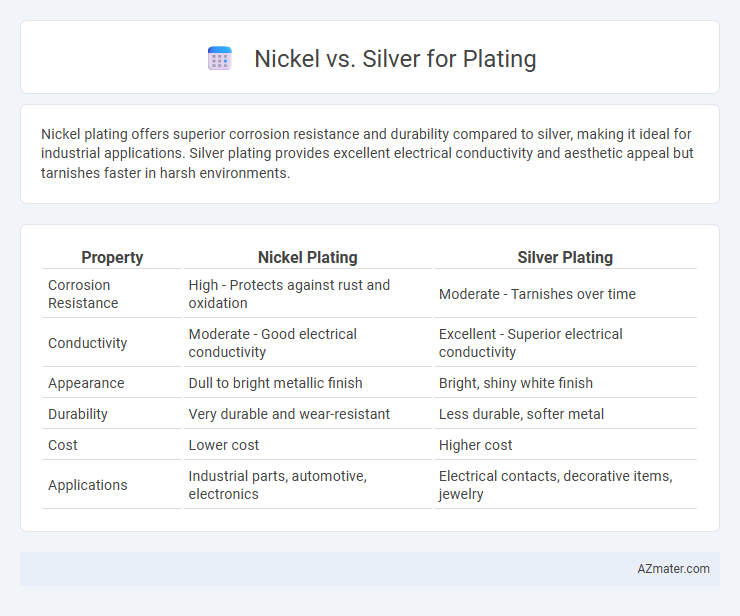Nickel plating offers superior corrosion resistance and durability compared to silver, making it ideal for industrial applications. Silver plating provides excellent electrical conductivity and aesthetic appeal but tarnishes faster in harsh environments.
Table of Comparison
| Property | Nickel Plating | Silver Plating |
|---|---|---|
| Corrosion Resistance | High - Protects against rust and oxidation | Moderate - Tarnishes over time |
| Conductivity | Moderate - Good electrical conductivity | Excellent - Superior electrical conductivity |
| Appearance | Dull to bright metallic finish | Bright, shiny white finish |
| Durability | Very durable and wear-resistant | Less durable, softer metal |
| Cost | Lower cost | Higher cost |
| Applications | Industrial parts, automotive, electronics | Electrical contacts, decorative items, jewelry |
Introduction to Metal Plating: Nickel vs Silver
Nickel and silver are two commonly used metals in plating, each offering unique properties suited for different applications. Nickel plating provides excellent corrosion resistance, durability, and a smooth, hard finish ideal for industrial and automotive uses. Silver plating offers superior electrical conductivity and antimicrobial properties, making it preferred for electronics, jewelry, and decorative purposes.
Key Properties of Nickel and Silver
Nickel offers exceptional corrosion resistance, high hardness, and excellent wear resistance, making it ideal for protective and decorative plating on metal surfaces. Silver provides superior electrical and thermal conductivity alongside a bright, reflective finish, which is highly valued in electronic components and ornamental applications. Both metals are favored for plating due to their unique properties, but nickel's durability contrasts with silver's conductivity and aesthetic appeal.
Aesthetic Differences in Plating Finishes
Nickel plating offers a bright, reflective finish with a slightly yellowish tint, providing a more industrial and durable appearance. Silver plating boasts a highly lustrous, white metallic shine that enhances elegance and reflects light more vibrantly, often preferred for decorative items. The aesthetic difference lies in nickel's warm, subtle sheen versus silver's cooler, striking brilliance, influencing the choice based on desired visual impact and application.
Corrosion Resistance: Nickel vs Silver
Nickel offers superior corrosion resistance compared to silver, making it an ideal choice for protective plating in harsh environments. Silver, while highly conductive and aesthetically appealing, tarnishes quickly when exposed to sulfur compounds and moisture. Nickel plating provides durable defense against oxidation and chemical degradation, extending the lifespan of coated metals in industrial applications.
Electrical Conductivity Comparison
Silver exhibits superior electrical conductivity at approximately 63 x 10^6 S/m compared to nickel's conductivity of about 14.3 x 10^6 S/m, making silver the preferred choice for high-performance electrical contacts and connectors. Nickel plating, while less conductive, offers excellent corrosion resistance and durability, often serving as an underlayer for silver plating to enhance mechanical strength. The conductivity difference significantly impacts applications requiring minimal electrical resistance, where silver's performance leads to lower energy losses and improved signal integrity.
Cost Analysis: Nickel Plating vs Silver Plating
Nickel plating offers a significantly lower cost compared to silver plating, making it a more budget-friendly option for large-scale industrial applications. Silver plating involves higher material expenses due to silver's market price volatility and requires specialized handling, increasing overall process costs. While nickel plating provides durable corrosion resistance at reduced cost, silver plating is preferred for its superior conductivity and aesthetic appeal despite the higher investment.
Common Applications in Industry
Nickel plating is widely used in automotive, aerospace, and electronics industries for corrosion resistance, wear protection, and enhancing surface hardness. Silver plating dominates in electrical and electronic applications due to its superior electrical conductivity and excellent thermal performance. Both metals are essential in manufacturing connectors, printed circuit boards, and decorative hardware, where the balance between cost and specific functional properties is critical.
Durability and Wear Resistance
Nickel plating offers superior durability and excellent wear resistance due to its hardness and corrosion resistance, making it ideal for industrial applications. Silver plating, while providing excellent electrical conductivity and aesthetic appeal, tends to wear faster and is more prone to tarnishing under abrasive conditions. For long-lasting protection in harsh environments, nickel plating outperforms silver in maintaining surface integrity and minimizing degradation.
Environmental and Safety Considerations
Nickel plating poses environmental risks due to the toxic waste and hazardous chemicals released during its electroplating process, requiring strict disposal protocols to prevent soil and water contamination. Silver plating offers better biocompatibility and lower toxicity but can lead to environmental concerns from silver ion release, which impacts aquatic life. Both metals demand careful handling and compliant waste management to minimize ecological and health impacts in industrial applications.
Choosing the Right Plating for Your Project
Nickel plating offers excellent corrosion resistance and durability, making it ideal for automotive, aerospace, and industrial applications where wear and tear are significant concerns. Silver plating provides superior electrical conductivity and a bright, reflective finish, suited for electronic components and decorative items requiring high aesthetic value. Selecting the right plating depends on balancing factors such as environmental exposure, conductivity needs, and desired appearance to ensure optimal performance and longevity.

Infographic: Nickel vs Silver for Plating
 azmater.com
azmater.com